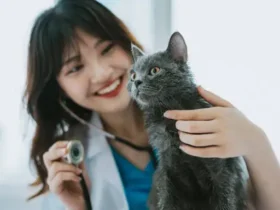Introduction
Administering eye drops to a cat can be daunting, but it’s often necessary for their health. Whether your feline friend is dealing with an eye infection, allergies, or another condition, knowing how to properly give them eye drops can make a big difference in their recovery. This guide will help you understand why your cat might need eye drops, the conditions that necessitate them, and most importantly, how to administer them safely without losing a hand.
Why Your Cat Might Need Eye Drops
Cats can develop a variety of eye conditions that require treatment with eye drops. Understanding these conditions can help you recognize when your cat needs medical attention.
1. Conjunctivitis
- Description: Conjunctivitis, or pink eye, is an inflammation of the conjunctiva, the pink membrane lining the eyelids. It can be caused by infections, allergies, or irritants.
- Symptoms: Redness, swelling, discharge, and excessive blinking.
- Treatment: Antibiotic or anti-inflammatory eye drops are commonly prescribed.
2. Corneal Ulcers
- Description: Corneal ulcers are open sores on the cornea, the clear outer layer of the eye. They can be caused by trauma, infections, or foreign objects.
- Symptoms: Squinting, eye redness, tearing, and cloudiness.
- Treatment: Eye drops containing antibiotics, antifungals, or antivirals are used to treat the underlying cause.
3. Glaucoma
- Description: Glaucoma is an increase in pressure within the eye that can lead to blindness if untreated. It’s often associated with other eye conditions.
- Symptoms: Eye pain, redness, cloudiness, and dilated pupils.
- Treatment: Eye drops that reduce intraocular pressure are essential in managing glaucoma.
4. Uveitis
- Description: Uveitis is inflammation of the uvea, the middle layer of the eye. It can be caused by infections, trauma, or immune-mediated diseases.
- Symptoms: Eye redness, pain, sensitivity to light, and squinting.
- Treatment: Anti-inflammatory and pain-relief eye drops are commonly prescribed.
5. Dry Eye (Keratoconjunctivitis Sicca)
- Description: Dry eye occurs when the tear glands don’t produce enough tears, leading to irritation and inflammation.
- Symptoms: Eye redness, discharge, squinting, and rubbing the eyes.
- Treatment: Lubricating eye drops or artificial tears help maintain moisture in the eye.
How to Administer Eye Drops to Your Cat
Administering eye drops to a cat can be challenging, but with the right approach, it can be done safely and effectively. Here’s a step-by-step guide to help you through the process.
1. Prepare the Eye Drops and Materials
- What You’ll Need:
- The prescribed eye drops.
- A clean cloth or cotton pad.
- Treats to reward your cat afterward.
- Tips:
- Shake the eye drop bottle if required.
- Have everything within reach before you start.
2. Create a Calm Environment
- Importance: Cats are sensitive to stress, and a calm environment helps minimize their anxiety.
- How to Do It:
- Choose a quiet room away from distractions.
- Speak to your cat in a soothing voice.
- Consider wrapping your cat in a towel to prevent scratching.
3. Position Your Cat Properly
- Options:
- On Your Lap: If your cat is cooperative, place them on your lap facing away from you.
- On a Table: For more control, place your cat on a table with a non-slip surface.
- Holding Technique:
- Use one hand to gently hold your cat’s head.
- Avoid applying too much pressure to the neck or throat.
4. Administer the Eye Drops
- Step-by-Step:
- Open the Eye: Use your thumb and forefinger to gently open your cat’s eyelids.
- Apply the Drops: Hold the eye drop bottle close to the eye without touching it. Squeeze the prescribed number of drops into the eye.
- Let Go: Allow your cat to blink naturally, which will help spread the medication across the eye.
- Tips:
- If your cat struggles, take a break and try again.
- Be quick but gentle to minimize stress.
5. Reward Your Cat
- Why It’s Important: Rewarding your cat helps create a positive association with the process.
- How to Do It: Give your cat their favorite treat or toy immediately after administering the drops.
Common Challenges and How to Overcome Them
Administering eye drops to a cat is rarely straightforward. Here are some common challenges and how to handle them.
1. Resistance and Struggling
- Solution: If your cat is highly resistant, try wrapping them in a towel to restrict movement. Ensure you’re calm, as your cat can sense your anxiety.
2. Missed Drops
- Solution: If you miss the eye or your cat blinks too soon, don’t panic. Wait a few minutes and try again. Avoid double-dosing if some drops made it in.
3. Fear of Hurting Your Cat
- Solution: It’s natural to worry about causing discomfort. Remember, the drops are designed to help. If you’re unsure, ask your vet to demonstrate the technique.
When to Seek Veterinary Assistance
While administering eye drops at home is often straightforward, there are times when you should seek veterinary help.
1. If Your Cat’s Condition Worsens
- Signs: Increased redness, swelling, or discharge after starting treatment.
- Action: Contact your vet immediately.
2. If You’re Unable to Administer the Drops
- Signs: Persistent difficulty in getting the drops into your cat’s eyes.
- Action: Your vet may administer the drops or recommend an alternative treatment.
3. If You Suspect an Adverse Reaction
- Signs: Swelling, excessive tearing, or signs of an allergic reaction after administering the drops.
- Action: Discontinue use and contact your vet.
Tips for Long-Term Eye Care in Cats
To minimize the need for frequent eye treatments, consider these tips for maintaining your cat’s eye health.
1. Regular Vet Check-Ups
- Schedule routine eye exams as part of your cat’s annual check-up.
2. Monitor for Symptoms
- Keep an eye out for signs of eye conditions, such as redness, discharge, or squinting.
3. Maintain a Clean Environment
- Reduce your cat’s exposure to irritants by keeping their living space clean.
4. Proper Nutrition
- Ensure your cat’s diet includes nutrients that support eye health, such as Vitamin A and taurine.
5. Eye Hygiene
- Regularly clean around your cat’s eyes with a damp cloth to remove any debris or discharge.
Conclusion
Administering eye drops to your cat may seem daunting, but with the right knowledge and techniques, it can be done safely and effectively. Understanding why your cat might need eye drops, recognizing common eye conditions, and following a calm, methodical approach can make the process easier for both you and your feline friend. Remember to reward your cat and seek veterinary help if needed. Your cat’s eye health is crucial, and proper care can prevent long-term issues.











Leave a Reply